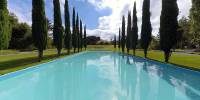
Pulgas Water Temple
San Francisco Peninsula Watershed, California, USA
June 21, 2005 09:33
© 2005 Erik Goetze, All Rights Reserved.
The Temple design features fluted columns and Corinthian capitals to reflect the architecture of ancient Greeks and Romans, whose engineering methods were used to build the San Francisco water system. The frieze above the columns says "I give waters in the wilderness and rivers in the desert, to give drink to my people."
San Francisco built the Pulgas Water Temple in 1934 as a monument to the engineering marvel that brought water more than 160 miles across California from the Sierra Nevada Mountains to the San Francisco Bay Area via aqueducts and the Tuolumne River.
San Francisco relies on the Tuolumne River for 85% of its water, taking an average of 235 million gallons from the river every day. The headwaters of the Tuolumne River begin with snowmelt from 13,114 foot Mount Lyell in Yosemite National Park. There are plans for San Francisco to increase the water it removes from the river up to 400 million gallons per day, which resulted in the Tuolumne River being named as one of the ten most endangered rivers in the US.
The history of the western US has numerous examples of cities exercising political muscle and/or capital to acquire distant water sources and pump water huge distances. After a century of water system development, the impact of removing vast amounts of water from the wilderness is increasingly being taken into consideration. The movie "Chinatown" paints a Hollywood dramatization of Los Angeles's history of locking up water rights in the Owens Valley & Mono Basin, east of the Sierra Nevada. Local residents, Inyo County, and environmental groups fought to halt the resulting desertification. After a long battle, the California State Water Resources Control Board ruled in 1994 to set minimum flows for Owens Valley streams, set limits on water extraction to allow the Mono Lake water level to increase from historic lows, and ordered LA's Water Department to restore area streams and wildlife habitat.
That's just the tip of the water backstory here in California. The water wars are likely to continue since so many constituencies (fishermen, farmers, boaters, industry, agriculture, cities, tourism) depend on limited amounts of freely flowing water.
Miscellaneous Notes: (In the panorama, the temple structure is 180 degrees from the opening view). The Pulgas Water Temple was closed for reconstruction for two and a half years, from March, 2002 until October, 2004. If you look down inside the temple, there's no water visible; only a mesh screen, some pipes, and the hum of machinery. While the grounds look like a great place for a picnic, the parking lot is closed on weekends. When I arrived here Tuesday morning, there were no other visitors, and a few SFPUC employees were beginning grounds work. As I shot six panoramas here, several runners went by, as the temple is midway along a trail that follows the edge of the SF Peninsula Watershed lands. There are numerous water fountains, and in my opinion, the water they dispense tastes better than almost any tap water.
Also see the Sunol Water Temple, photographed by Landis Bennett for the WWP.
Lat: 37° 29' 0" N
Long: 123° 19' 0" W
Elevation: 307 feet
Precision is: Unknown / Undeclared.


 Tap or click the zoom icon in the bottom right corner of the picture to switch between in-page and fullscreen view
Tap or click the zoom icon in the bottom right corner of the picture to switch between in-page and fullscreen view